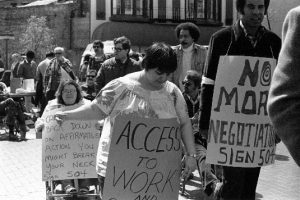
This is a great simple civics lesson with three distinctive case studies: marchers with disabilities who took over federal buildings in a historic sit-in in 1977 (the 504 protests), young American volunteers in the Spanish Civil war in 1936, and a 12-year-old mill worker who was inspired to lead a walk-out in 1898. The lesson addresses new content in the 2018 US History II Framework for Massachusetts as it asks students, “did the protesters go too far” and invites them to consider the constitutional underpinnings of individual and collective civic engagement.
In the words of Harrison Quinn, the teacher who developed this lesson plan, “A lot of students look at history and citizenship as something that is done only by famous, larger-than-life, historical figures. History is mainly made by thousands of people, who will never be in the history books, working in their own community to make change. In this lesson, students will watch, listen, and read primary sources (case studies) of Americans exercising their rights to make a change.”
In addition to its emphasis on civic engagement, this lesson can serve as an introduction to the history of the U.S. Labor Movement, resistance to fascism in the Spanish Civil War, and Disability History and issues of access to full societal participation. The lesson can also stand alone as a single-session Civics lesson on how the rights enumerated in the US Bill of Rights have been claimed by individuals who defied authority for a cause they believed in.
Download:


